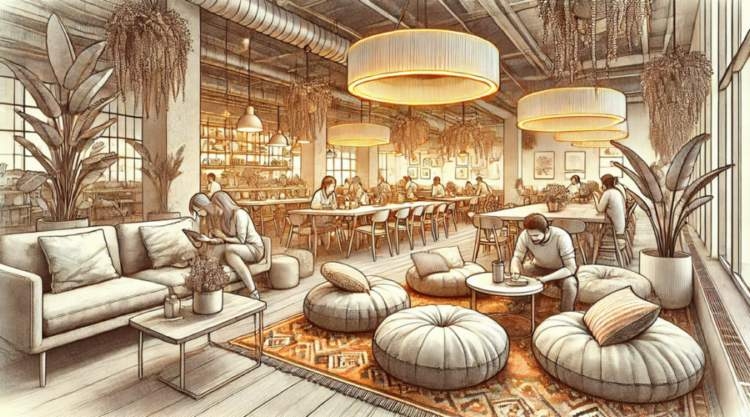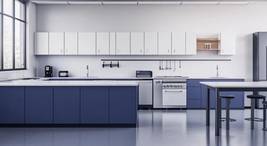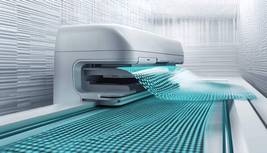Why Your Office Canteen Feels Like a Waiting Room (And How to Fix It)

Lighting: Less Interrogation, More Conversation
Fluorescent lights are the office canteen’s way of telling you that life is about efficiency, not comfort. Harsh, flickering overheads make even the best spaghetti bolognese look like a science experiment gone wrong.
Warm lighting, on the other hand, tricks the brain into thinking you’re somewhere pleasant—like your grandmother’s kitchen, where the only interrogation is about why you’re still single. Studies show that warm light encourages relaxation and social interaction, while cold, bright light increases alertness but makes everyone look like extras in a hospital drama.
Swapping out those blinding panels for soft pendant lights or LED bulbs in the 2700K-3000K range gives the space a glow that says, “Stay a while,” rather than “We close in five minutes.” For bonus points, add some dimmable options. That way, the canteen can shift from “lunchtime buzz” to “late-afternoon existential coffee break” at the turn of a dial.
Rugs and Soft Furnishings: Why Hard Surfaces Are Plotting Against You
If you’ve ever dropped a spoon in a corporate cafeteria, you’ll understand why hard floors and echoing walls are the enemy of comfort. The sound of cutlery hitting linoleum is roughly as soothing as a fire alarm.
Adding soft furnishings like cushioned chairs, fabric-covered booths, and—most importantly—rugs absorbs sound and makes the whole space feel less like a cafeteria and more like an inviting nook where secrets are whispered over soup. Textured surfaces also have a sneaky way of making people feel at ease. Plush fabrics, soft wool blends, and even a well-placed chunky-knit throw can convince the brain that it’s somewhere it actually wants to be.
A well-chosen rug doesn’t just provide sound insulation—it also visually anchors a seating area, breaking up the sterile expanses of neutral tile or laminate flooring. And if management is worried about spills? Machine-washable rugs exist. Science has given us Wi-Fi and vaccines; surely, it can handle a bit of soup absorption.
Cushions: The Silent Heroes of Comfort
For reasons unknown, many office canteens subscribe to the philosophy that chairs should be as firm and unyielding as an auditor’s handshake. This is deeply flawed logic. No one wants to enjoy their break while perching on something that feels like a medieval punishment device.
Cushions—glorious, personality-filled, ergonomically generous cushions—offer an instant upgrade. They add texture, visual warmth, and, most importantly, the possibility of sitting down without feeling like you’ve miscalculated your life choices. Mixing patterns and sizes helps prevent that sterile, “corporate lounge” aesthetic and replaces it with a more relaxed, lived-in atmosphere.
And before the skeptics argue that cushions will just end up on the floor—good. That’s proof that people are getting comfortable. If an employee is willing to plop down cross-legged on a rug with a plate of pasta, congratulations: you’ve officially made the canteen feel like home.
Why Your Canteen Deserves Softer Edges
Most office canteens seem to have been designed by people who believe that “efficiency” and “warmth” cannot coexist. Everything is sharp angles, hard plastics, and tables that resemble exam desks more than places for casual conversation.
But the human brain is wired to respond positively to softer, organic shapes. Curved edges and rounded furniture create a sense of ease, tricking us into letting our guard down. This isn’t just interior design fluff—it’s backed by research. Studies in neuroaesthetics (yes, that’s a real thing) show that curved shapes activate the parts of the brain associated with pleasure, while sharp angles tend to evoke caution and stress.
By swapping out those rigid cafeteria chairs for curved-backed ones or adding a few round tables, the canteen can shift from feeling like a corporate break room to a café where people actually enjoy their coffee. Bonus points if you throw in some upholstered benches or armchairs. Suddenly, the canteen isn’t just a place to shovel in food before the next meeting—it’s a space where people actually want to linger.
Small Touches, Big Impact
Making an office canteen feel like home doesn’t mean turning it into a bohemian lounge (unless you want to, in which case, carry on). Sometimes, the smallest changes make the biggest difference. Here are a few subtle yet powerful ways to soften up the space:
- Plants: They add life, improve air quality, and make people feel like they’re somewhere worth existing.
- Textured placemats or table runners. Small details, but they break up the monotony of sterile surfaces.
- Bookshelves with cookbooks or magazines. Encourages lingering and gives people something to browse while pretending to be deep in thought.
- A decent coffee station. Nothing says “homely” like a real coffee machine instead of a sad vending one that dispenses liquid despair.
None of these changes require a full-scale renovation, yet they work together to make the canteen feel more inviting. It’s about creating an atmosphere that whispers, “Relax, you’ve earned this break,” instead of shouting, “Eat fast and leave.”
Let There Be Cozy
The office canteen has the potential to be more than just a place where employees refuel—it can be a space where they actually enjoy spending time. Warm lighting, soft textures, and thoughtfully chosen furnishings can take it from “sterile lunchroom” to “the heart of the office.”
Sure, some people might resist change at first. But once they’ve settled into a cushioned chair, basking in the glow of non-fluorescent lighting, with a real coffee in hand and maybe a plant or two in their peripheral vision, they’ll understand: a cozy canteen isn’t just nice to have. It’s a necessity.
And if management needs extra convincing? Remind them that happy employees are productive employees. Or, failing that, just swap out their cold plastic chair for a plush armchair and see how quickly their perspective softens.
|
|


